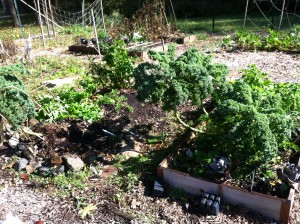I’m fortunate to have a small plot in the Chappaqua Community Garden. Its less than a mile from my house, it offers full sun and fence that keeps the critters out.
Now that we’ve had our first frost, many plants are done for the season. Say goodbye to basil, peppers, tomatoes. I was lucky enough to get down there to harvest my little crops last Friday before it hit 27 degrees at night.
But many veggies and herbs survive in cold weather. My parsley is doing fine, even the cilantro survived the brief freeze. My celery is still green and happy too. Carrots and beets are unaffected by the frost so they are carrying on as well.
Some veggies thrive in the cold weather. Namely my kale and cabbage. They are thrilled that the frost killed off a few of the pests that like to munch on them and they start to taste even better as the temperatures get colder.
The parsnip seeds that I tossed in my garden beds in August as a random experiment have grown like wildfire. They are another plant that loves to cold and gets even better tasting after a few frosts.
The secret to a fall garden filled with food is prior planning. I started seeds in mid August for these fall crops. Seeds get started easily in the warm soil, but don’t grow like gang busters because the days get shorter, even in August. Slow and steady wins the race. I look forward to lots of carrots, beets, parsnips and kale for at least a couple more months.
Less than 100 years ago, we had no food being trucked or flown into town from distant warmer locations. Local food tastes better than food from far away and has a higher nutrient content as well.
In the not too distant future, we might not be able to rely on cheap, abundant food from far away. Climate change has been wrecking havoc with crop yields and as resources like water and oil become less available, we won’t be taking food for granted anymore. This is one of many reasons why I’m growing food close to home.



